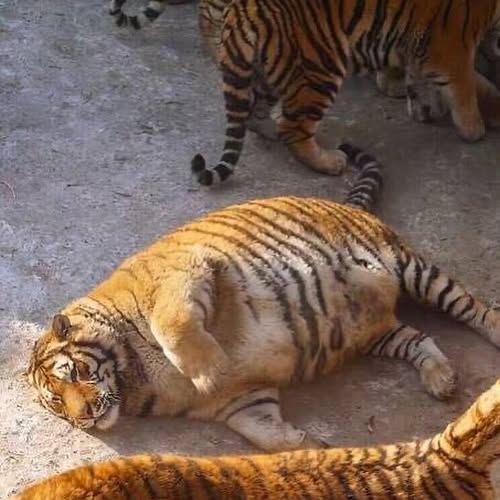Why These Round Tigers Are Taking Over the Internet—And What Their Fluffy Appearance Is Really Hiding
It all started with a photo. A tiger, not fierce and lean like you’d expect, but soft and round, lounging peacefully in the snow behind a chain-link fence. The internet fell in love instantly. “Ever seen a chubby tiger?” the caption read, and within hours, thousands of likes, retweets, and emojis followed. Some joked it looked like a giant stuffed animal. Others wanted to hug it. And many just couldn’t stop staring at how adorably oversized it looked.
But behind the viral fluffiness of these Siberian tigers from wildlife parks in northeast China lies a story that’s not all fun and games. These aren’t your average wild cats roaming free in the forests. They’re in captivity—fed well, kept safe from predators, and living in controlled environments. And while the warmth of steady care is nice, it also brings something unexpected: weight gain.
Now, to be fair, Siberian tigers do naturally bulk up in winter. Their thick fur and added fat help insulate them from the brutal cold of the Russian Far East and northern China, where temperatures can plunge below -30°C. In the wild, this seasonal weight gain is crucial for survival. But in zoos or wildlife parks, where food is regular and movement is limited, the “winter weight” can become something more—something that borders on obesity.
That’s when concern starts to grow. Because as much as people love seeing a round tiger roll in the snow, animal health experts begin to worry. A tiger that carries too much weight for too long risks the same issues a human might: joint problems, sluggishness, heart strain, and shortened life expectancy. And since these creatures are endangered—only around 500 Siberian tigers exist in the wild—each individual matters.
Still, it’s hard not to smile when you see them. The round shape, the squished face, the way they waddle rather than stalk—it triggers the same fuzzy feeling we get when we see a chubby housecat or a rotund panda. But it’s also a reminder that not everything viral is harmless.

The Balance Between Captivity and Wild Instinct
The parks where these tigers live are often designed with care, especially the large Siberian Tiger Park in Harbin, China, which houses hundreds of tigers across several enclosures. Caretakers feed them red meat, often in generous amounts, and the environment mimics their natural habitat to some degree. But no matter how much snow they’re surrounded by or how tall the fences, it’s not the same as the open wild.
Tigers in nature are solitary hunters. They patrol wide territories, track prey for hours, and use stealth, strength, and bursts of explosive energy to survive. Every kill is hard-earned, and every day is unpredictable. Captivity removes that challenge. It offers consistency but takes away the natural rhythm of life.
Some zoos and parks try to combat this by creating enrichment activities—giving tigers toys to “hunt,” hiding their food in difficult places, or even building hills and trees for them to climb. These tricks help, but they’re not perfect. When food comes too easy and space is too limited, weight gain becomes a likely outcome.
One Chinese wildlife expert, interviewed after the viral photos blew up, admitted that while the tigers weren’t in immediate danger, their weight was being monitored. “They eat well during winter,” he said. “And they move less when it’s cold. We’re working on ways to encourage more activity.” A few parks even started mini fitness programs for their tigers—longer walking periods, smaller food portions, and more mental stimulation.
On the internet, reactions are mixed. Some users comment things like “he’s just living his best life” or “leave him alone, he’s cute!” Others point out the ethical side of it. “This isn’t a plush toy,” one post read. “It’s an endangered predator. It deserves a life that reflects that.”
Still, the fascination continues. One viral post featured a tiger so round, someone joked it looked like “a basketball in a fur coat.” A meme showed a side-by-side of a wild tiger versus a zoo tiger with the caption: “Before and after quarantine.” The mix of humor and worry is real. And that makes sense—it’s hard to know how to feel about something that looks so lovable but might not be as healthy as it appears.
In many ways, these round tigers have become accidental ambassadors for an important conversation. How do we treat wild animals in captivity? Are we keeping them safe or keeping them tame? And how do we balance human love with animal dignity?
These are big questions, and a tiger’s belly might seem like a small place to start. But that’s how it goes sometimes. Big stories can come from unexpected places—especially when they’re covered in fur and stripes.
So next time you see a chubby tiger pop up on your timeline, go ahead—smile at it. But maybe also take a second to think about where that tiger lives, how it got that way, and what it says about the world we’ve created for wild creatures who can no longer roam free.
Because even in captivity, a tiger deserves more than just likes.

Daniel Reed is a curious mind with a passion for breaking down how the world works. With a background in mechanical engineering and digital media, he turns complex ideas into easy-to-understand articles that entertain and inform. From vintage tools and modern tech to viral internet debates and life hacks, Daniel is always on the hunt for the “why” behind the everyday. His goal is simple: make learning feel like scrolling through your favorite feed — addictive, surprising, and fun.
